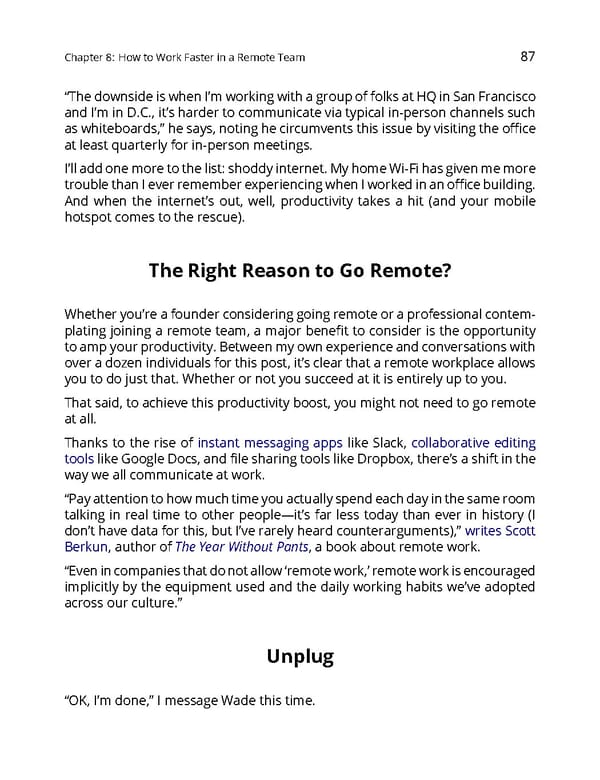Chapter8: HowtoWorkFasterinaRemoteTeam 87 “ThedownsideiswhenI’mworkingwithagroupoffolksatHQinSanFrancisco andI’minD.C.,it’s harder to communicate via typical in-person channels such aswhiteboards,”hesays,notinghecircumventsthisissuebyvisitingtheoffice at least quarterly for in-person meetings. I’ll add one moretothelist:shoddyinternet.MyhomeWi-Fihasgivenmemore troublethanIeverrememberexperiencingwhenIworkedinanofficebuilding. And when the internet’s out, well, productivity takes a hit (and your mobile hotspot comestotherescue). TheRightReasontoGoRemote? Whetheryou’reafounderconsideringgoingremoteoraprofessionalcontem- plating joining a remote team, a major benefit to consider is the opportunity toampyourproductivity.Betweenmyownexperienceandconversationswith overadozenindividualsforthispost,it’sclearthataremoteworkplaceallows youtodojustthat.Whetherornotyousucceedatitisentirelyuptoyou. That said, to achieve this productivity boost, you might not need to go remote at all. Thanks to the rise of instant messaging apps like Slack, collaborative editing tools like Google Docs, and file sharing tools like Dropbox, there’s a shift in the wayweallcommunicateatwork. “Payattentiontohowmuchtimeyouactuallyspendeachdayinthesameroom talking in real time to other people—it’s far less today than ever in history (I don’t have data for this, but I’ve rarely heard counterarguments),” writes Scott Berkun, author of The Year Without Pants, a book about remote work. “Evenincompaniesthatdonotallow‘remotework,’remoteworkisencouraged implicitly by the equipment used and the daily working habits we’ve adopted across our culture.” Unplug “OK, I’m done,” I message Wade this time.
 The Ultimate Guide to Remote Work Page 90 Page 92
The Ultimate Guide to Remote Work Page 90 Page 92